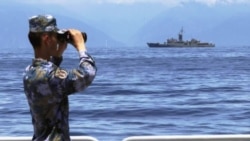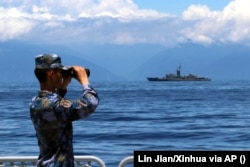On August 28, the U.S. Navy’s 7th Fleet sailed through international waters off the Chinese mainland to demonstrate a “commitment to a free and open Indo-Pacific.”
The next day, Reuters asked Chinese Foreign Ministry spokesman Zhao Lijian about that transit of U.S. vessels near Taiwan, where tensions have run high since U.S. House Speaker Nancy Pelosi’s controversial August 2 visit.
Zhao cited the People’s Liberation Army Eastern Theater Command, which said the Chinese military kept “all movements of the two US warships under control.”
“U.S. warships frequently flex muscles in the name of exercising freedom of navigation,” Zhao said.
“This is not about keeping the region free and open. This is provocation aimed at ‘freedom of trespassing’ and it constitutes deliberate sabotage of regional peace and stability.”
Zhao’s accusation of trespassing is false.
Although China blames the U.S. for sabotaging “regional peace and security,” the record shows that it is Beijing that repeatedly threatens its neighbors through sweeping claims of sovereignty over the sea, along with other aggressive actions.
The 7th Fleet said that the freedom of navigation operation was done “in accordance with international law,” noting the ships “transited through a corridor in the Strait that is beyond the territorial sea of any coastal state.”
It added that the United States Navy would continue operating “anywhere international law allows.”
Such freedom of navigation operations did not come out of the blue.
China attempts to control what vessels can operate where in the region, imposing the so-called “nine-dash line,” an arbitrary boundary that Beijing claims gives it control over most of the South China Sea.
But the U.N. Convention on the Law of the Sea (UNCLOS) clearly outlines the territorial waters of coastal states (like China) and archipelagic states or island nations (like Indonesia and the Philippines).
The territorial waters of China extend 12 nautical miles from its low-water mark or baseline.
Moreover, Article 19 of UNCLOS, which concerns innocent passage, allows foreign ships, even military vessels, to pass through the territorial waters of another state so long as that passage is “not prejudicial to the peace, good order or security of the coastal state.”
Coastal states cannot claim territorial waters around submerged features and low-tide elevations (that is, a naturally formed area of land submerged during high tide) which fall outside of their territorial waters.
China, however, did just that in 2009, imperiously claiming it had “indisputable sovereignty over the islands in the South China Sea and the adjacent waters, and enjoys sovereign rights and jurisdiction over the relevant waters as well as the seabed and subsoil thereof.”
In 2016, following a challenge by the Philippines, the Arbitral Tribunal at the Permanent Court of Arbitration in The Hague rebuked China’s sweeping claim.
China has ignored that ruling as it intensifies efforts to control most of the South China Sea, while bullying neighboring countries that attempt to assert their rights.
As for “trespassing,” China has repeatedly launched incursions into its neighbors’ back yards by claiming territories that fall within the countries’ 200-mile exclusive economic zone (EEZ)s.
Some countries, like Malaysia, have attempted to engage in “quiet diplomacy” over China’s claims, although a June 2021 flight by 16 Chinese warplanes over Sarawak, a Malaysian state on the island of Borneo, prompted protest.
Indonesia has also faced Chinese encroachment in what it calls the North Natuna Sea, which falls in Indonesia’s EEZ in the southern portion of the South China Sea.
Beni Sukadis, a national security analyst at Indonesia’s Institute of Defense and Strategic Studies, said the Malaysian and Indonesian navies respond to incursions by Chinese Coast Guard vessels by “shadowing” them “rather than confronting them and forcing them to leave.”
That practice, he said, reflected their risk calculus “regarding Beijing’s assertiveness.”
Indonesia has tried not to upset the apple cart with China, and is officially a non-claimant state in the South China Sea.
But earlier this month, more than 5,000 soldiers from the U.S., Indonesia, Australia, Japan and Singapore took part in joint combat exercises on Indonesia’s Sumatra island.
Elsewhere in the region, China has repeatedly sunk Vietnamese fishing boats near the Paracel Islands, and reportedly used the threat of force to halt Vietnamese drilling projects that fall within the nine-dash line.
The Philippines has lodged more than 300 diplomatic protests against Beijing's actions in the South China Sea.
In November 2021, China’s Coast Guard blocked and used water cannons against Philippine resupply ships headed to the Second Thomas (Ayungin) Shoal, a submerged reef in the contested Spratly Islands that falls within the Philippines’ EEZ.
On June 9, the Philippines “protested the return of over 100 Chinese vessels illegally operating in the waters in and around Julian Felipe (Whitsun) Reef,” which also falls within the country’s EEZ.
That incident occurred roughly one year after more than 200 Chinese ships “swarmed” the area, igniting tensions.
While the Philippines has also sought to avoid going to war with China over the South China Sea, earlier this year the United States and Philippines carried out their largest-ever joint military drills in the shadow of China-Taiwan tensions.
In March, a top U.S. Navy commander said China had militarized at least three islands in the South China Sea, equipping them with “anti-ship and anti-aircraft missile systems, laser and jamming equipment, and fighter jets,” The Associated Press reported.
That, the commander said, constitutes China’s “largest military buildup since World War II.”
The Asia Maritime Transparency Initiative says China has established 20 outposts on island groups in the region. The initiative is a project of the Center for Strategic and International Studies, a Washington, D.C., think tank.








